I told you that this week we’d talk about our Holy Mother Mary of Egypt, who we commemorate this Fifth Sunday of Great Lent. Yesterday, just as I had her Post all ready to go, suddenly I thought: This sounds very familiar. Guess what? I told you her story last year!
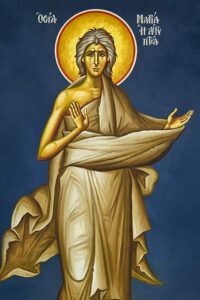
You can find her back in Post 175: “How to make a Confession without making a Confession” – so titled because I figured not many would be able to make an actual Confession last year because of the Pandemic.
courtesy of Greek Archdiocese of North America
Only two things to add:
1 The full story of Saint Mary of Egypt, written by Patriarch Sophronius of Jerusalem in about the year 635, is well worth reading. You can find it online, for example: https://stmaryofegypt.org/files/library/life.htm.
2 She has been so popular that over the centuries her story has been translated into Latin, Slavonic, Russian, Georgian, French, Spanish, Dutch, Portuguese, Italian, German, Norwegian, Swedish, Finnish, English, Armenian, Ethiopian, Syrian, Ukrainian, several Alaskan dialects, Chinese, Japanese, Korean, several African languages, and probably more. (from “The Marvelous Life of Patriarch Sophronius”, by Mother Nectaria McLees, in the Journal Road to Emmaus, Vol XI, No. 4.
Saints overshadowed by Holy Week, Pascha and Bright Week
You know that the dates of these All-Holy Times shift a lot from year to year (Why? … oh, let’s not get into that.) They always “take precedence” over all else, so saints whose feast days fall during April and early May often vanish from our sight. I feel kind of sorry for them, though probably they in their humility don’t mind. Anyway, let’s talk about three particularly notable ones who’ll get overlooked this year.
April 25, Palm Sunday – Mark the Evangelist
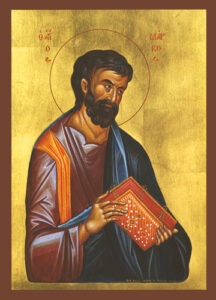 His name was John Mark. His mother’s name was Mary. He was a young man. It was In the “upper room” of their home in Jerusalem that the Lord’s Last Supper took place.
His name was John Mark. His mother’s name was Mary. He was a young man. It was In the “upper room” of their home in Jerusalem that the Lord’s Last Supper took place.
Only Mark reports the incident of the young man who that night went to Gethsemane wearing only a “sindon”, a fine linen garment – it sounds as if he sneaked out of the house. When a soldier tried to apprehend him, he lost his garment and fled naked. Mark 14:51-52 There seems to be no particular point to this story, except that tradition says Mark was that young man.
Except as noted, Icons are by permission of Saint Isaac’s Skete at skete.com
Likewise, Christ’s Pascha night appearance and the descent of the Holy Spirit took place in their home. Imagine the effect this would have on young John Mark.
Mark was born in Cyrene in what is now Libya, North Africa. Tradition says he was related to the Apostle Barnabas, and the Apostle Peter was an in-law who instructed him in the Faith. They remained close, as we shall see.
After Pentecost, Mark at first accompanied Paul and Barnabas in their journeys proclaiming the Gospel in many places. He returned home to Jerusalem for a while, but then went with Barnabas to Cyprus.
Sometime during this period he was with the Apostle Peter 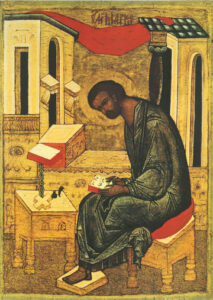 and recorded Peter’s “memoirs”, which became the Gospel according to Saint Mark. This is the shortest of the Gospel accounts.
and recorded Peter’s “memoirs”, which became the Gospel according to Saint Mark. This is the shortest of the Gospel accounts.
The stories are overall the same as in the other two “Synoptic Gospels” (Matthew, Luke), but often abbreviated. Mark includes no birth stories; he begins with the Baptism of Jesus. His Resurrection account is very “condensed”. In recent times, some scholars have had much fun trying to figure how why they are so similar, yet also different. My humble advice is: Give it up. The Church accepted them from the beginning, so just read them and let Jesus speak to you.
Dates are sketchy here, but probably after the martyrdom of Peter in Rome (about the year 65), Mark went to North Africa, settling in the great city Alexandria.
The Church grew there. Mark was their first Bishop, and he ordained presbyters and deacons. However, pagan opposition was so dangerous that his people urged him to leave for a while. He went west to the Five Cities, then returned. A Christian church was built.
One year the celebration of Pascha took place at the same time as a great pagan festival. A mob attacked the church. (Alexandria seems an excitable city: they burned down the great Alexandrian library, destroying vast amounts of ancient knowledge. They almost got Patriarch Athanasios.) In this case they bound Bishop Mark, dragged him through the streets, then threw him into prison. The second day they did the same. This time he gave up his soul to his Lord as a martyr.
That night the pagans tried to burn Mark’s body, but a great rain storm arose, which allowed Christians to rescue his relics. These they placed in a coffin and buried him in a secret place in the church, which came to be called Saint Mark’s Church. After Christianity was freed by Constantine the Great, Mark was given a place of honor, and there he remained – until in the year 823 Italian sailors stole his relics (somehow missing his head) and took them to Venice, where the famous Saint Mark’s Basilica was built to house them.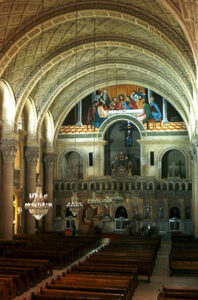
There his relics remained until June 24, 1968, when after seven centuries Pope Paul VI of Rome permitted them to be returned. Pope Kyrillos of the Coptic Orthodox Church traveled to Rome to bring him home, and now he lies again happily in Saint Mark’s Coptic Orthodox Cathedral, Alexandria.
April 30, Holy Friday – James the Apostle, Brother of Apostle John the Theologian
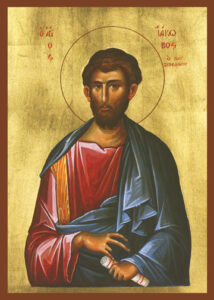 Often called James the Greater, to distinguish him from James, Brother of the Lord, first Bishop of Jerusalem.
Often called James the Greater, to distinguish him from James, Brother of the Lord, first Bishop of Jerusalem.
James and John were sons of Zebedee the fisherman. They were working at their nets when Jesus came and said “Follow me, and I will make you fishers of men.” Matthew 4:19 They left everything and followed Him.
Peter, James and John were Jesus’ “inner circle”. They alone were called to accompany Him to the top of Mount Tabor to witness His Transfiguration, and to be closest to Him in His agony in the Garden of Gethsemane. Mark 14:33
Jesus nicknamed James and John “sons of thunder” (Boanerges / Βοανηργές, literally “thunderbolts”!) To illustrate: A Samaritan village refused to welcome Him. James and John asked Him, “Lord, do you want us to call down fire from heaven to consume them?” Jesus turned and rebuked them: “You do not know what kind of spirit you are of; for the Son of Man did not come to destroy men’s lives, but to save them.” Luke 9:54-55
After Pentecost James remained in Jerusalem, a dangerous thing to do. About the year 44 “King Herod arrested some who belonged to the Church, intending to persecute them. He had James, the brother of John, put to death with the sword.” Acts 12:1-2 He was the first of the Apostles to die.
A Spanish legend says James traveled to Spain. Very dubious. However, it is likely that his relics were taken to Spain. The greatest medieval pilgrimage route was “O Camiño de Santiago” (The Way of Saint James) which led to the cathedral of Santiago de Campostella in northwest Spain, where they say he lies and is much venerated today.
May 1 Holy Saturday – the Prophet Jeremiah
It’s such a shame. So far as I know Western Christians never commemorate the prophets, these great witnesses to the word and power of God, to whom God spoke directly. We Orthodox have them on our calendars, but except for the prophet Elijah (Elias) we almost ignore them. During Lent Isaiah is read in church – but at the Noonday office, which usually only monastics attend.
So let’s give the great prophet Jeremiah (Jeremias) his due.
 Jeremiah prophesied from 613 to 583 B.C. He lived through the fall and destruction of Jerusalem in the year 597 and the exile of the people into Babylon. His scribe Baruch recorded his prophecies, and also included much of the history of the times.
Jeremiah prophesied from 613 to 583 B.C. He lived through the fall and destruction of Jerusalem in the year 597 and the exile of the people into Babylon. His scribe Baruch recorded his prophecies, and also included much of the history of the times.
Jeremiah saw it coming, and he knew why.
“Now the word of the Lord came to me saying: ‘Before I formed you in the womb I knew you; before you were born I set you apart; I appointed you as a prophet to the nations.’ ‘Alas, Sovereign Lord,’ I said, ‘I do not know how to speak; I am too young.’ But the Lord said to me, ‘Do not say, ‘I am too young.’ You must go to everyone I send you to and say whatever I command you. Do not be afraid of them, for I am with you and will rescue you,’ declared the Lord. Then the Lord reached out his hand and touched my mouth and said to me, ‘I have put my words in your mouth. See, today I appoint you over nations and kingdoms to uproot and tear down, to destroy and overthrow, to build and to plant.’
The Lord said to me, ‘From the north disaster will be poured out on all who live in the land… Their kings will come and set up their thrones in the entrance of the gates of Jerusalem; they will come against all her surrounding walls and against all the towns of Judah. I will pronounce my judgments on my people, because of their wickedness in forsaking me, in burning incense to other gods and in worshiping what their hands have made…. Get yourself ready! Stand up and say to them whatever I command you. Do not be terrified by them.'” Jeremiah 1:4-15
This did not make Jeremiah popular. True prophets rarely are.
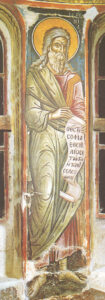 When Jerusalem fell, Jeremiah was among the few permitted to remain behind. He was overwhelmed by the horror. Baruch recorded the book of The Lamentations of Jeremiah. “Oh, how lonely she sits, the city once thronged with people, as if suddenly widowed. Though once great among the nations, she… is now reduced to vassalage… The roads to Zion are all in mourning; no one comes to her festivals now. Her gateways are all deserted… The Lord has made her suffer for her many many sins.., all the glory has departed from the daughter of Zion…” Lamentations 1:1-8
When Jerusalem fell, Jeremiah was among the few permitted to remain behind. He was overwhelmed by the horror. Baruch recorded the book of The Lamentations of Jeremiah. “Oh, how lonely she sits, the city once thronged with people, as if suddenly widowed. Though once great among the nations, she… is now reduced to vassalage… The roads to Zion are all in mourning; no one comes to her festivals now. Her gateways are all deserted… The Lord has made her suffer for her many many sins.., all the glory has departed from the daughter of Zion…” Lamentations 1:1-8
Then the few remaining in Jerusalem fled to Egypt, forcibly taking Jeremiah and Baruch with them. There he continued to prophesy. Finally it got to be too much. His own people stoned Jeremiah to death.
Jeremiah says so many good things. Let’s at least include these prophecies:
“Behold, the days are coming,” declares the Lord, “when I will raise up for David a righteous Branch; and He will reign as king and act wisely, and do justice and righteousness in the land.” Jeremiah 23:5
“The days are coming,” declares the Lord, “when I will make a New Covenant with the house of Israel and with the house of Judah.” Jeremiah 31:31
May 2, Great and Holy Pascha
There are only lesser saints on May 2 – granted that none are “lesser”, else they wouldn’t be seen as saints. * However, just in case you think you know about most of the saints, you don’t, nor do I.
- Any clergy who are reading this: On Sundays, please tell your people about some of the saints of the day. Immerse them in and inspire them by the stories of the Church’s heroes and heroines – and thereby in Church history. They’re not going to learn any of this anywhere except in church – certainly not from our surrounding Protestant / Catholic / secular culture.
Here is the full list of saints on the Orthodox calendar for May 2, taken from Orthodox Wiki. By pushing on the blue print, you can learn about a few of them. If you search (Google or whatever) you can learn about many of the rest. Particularly interesting, I think, are the Martyrs Boris and Gleb left below, courtesy of Pravmir, and Matrona the Blind, Wonderworker of Moscow, who died in 1952. right, below
May 2: Martyrs Hesperus, Zoe, and their sons Cyriacus and Theodulus, at Attalia (ca. 124); Venerable Jordan the Wonder-worker; Saint Sabbas, Bishop of Dafnousia; Saint Boris-Michael, Equal-to-the-Apostles, prince and baptizer of Bulgaria (907); Saint Valentine, Bishop of Genoa in Italy ca.295-307, (ca.307); Saint Germanus of Normandy, converted by St Germanus of Auxerre, martyred in France (ca.460); Hieromartyrs Vindemialis, Eugene and Longinus, Bishops in North Africa martyred by the 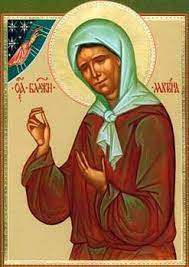 Arian Vandal King Hunneric (ca.485); Saint Neachtain, a relative of St Patrick of Ireland at whose repose he was present (5th c.); Saint Ultan, Irish monk, brother of Saints Fursey and Foillan (657); Saint Waldebert (Walbert, Gaubert), abbot of Luxeuil in France (ca.668); Saint Bertinus the Younger, Benedictine monk at Sithin, in France (699); Saint Felix of Seville, deacon and martyr in Seville, Spain, under the Muslims; Martyr Wiborada, anchoress of St. Gallen Abbey in Germany (926) (see also May 11); St. Athanasius of Syandem and Valaam (ca. 1550); Patriarch Athanasius III Patelaros, of Constantinople, from
Arian Vandal King Hunneric (ca.485); Saint Neachtain, a relative of St Patrick of Ireland at whose repose he was present (5th c.); Saint Ultan, Irish monk, brother of Saints Fursey and Foillan (657); Saint Waldebert (Walbert, Gaubert), abbot of Luxeuil in France (ca.668); Saint Bertinus the Younger, Benedictine monk at Sithin, in France (699); Saint Felix of Seville, deacon and martyr in Seville, Spain, under the Muslims; Martyr Wiborada, anchoress of St. Gallen Abbey in Germany (926) (see also May 11); St. Athanasius of Syandem and Valaam (ca. 1550); Patriarch Athanasius III Patelaros, of Constantinople, from 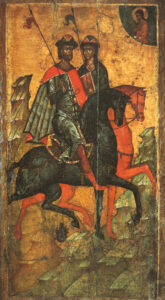 Lubensk (Lubny), Wonderworker (1654); Blessed Basil of Kadom, fool-for-Christ (1848); Saint Matrona the Blind, the Righteous Wonderworker of Moscow (1952) Other Commemorations: Translation of the relics of Patriarch Athanasius of Alexandria (373); Translation of the relics (1072 and 1115) of the holy passion-bearers Boris and Gleb (in holy baptism Romanus and David) (1015); Icon of the Theotokos of Putivilsk (1238, 1635).
Lubensk (Lubny), Wonderworker (1654); Blessed Basil of Kadom, fool-for-Christ (1848); Saint Matrona the Blind, the Righteous Wonderworker of Moscow (1952) Other Commemorations: Translation of the relics of Patriarch Athanasius of Alexandria (373); Translation of the relics (1072 and 1115) of the holy passion-bearers Boris and Gleb (in holy baptism Romanus and David) (1015); Icon of the Theotokos of Putivilsk (1238, 1635).
All you saints, pray to God for the salvation of our souls.
Next Friday we’ll begin our annual series of Daily Commentaries on Holy Week Services.